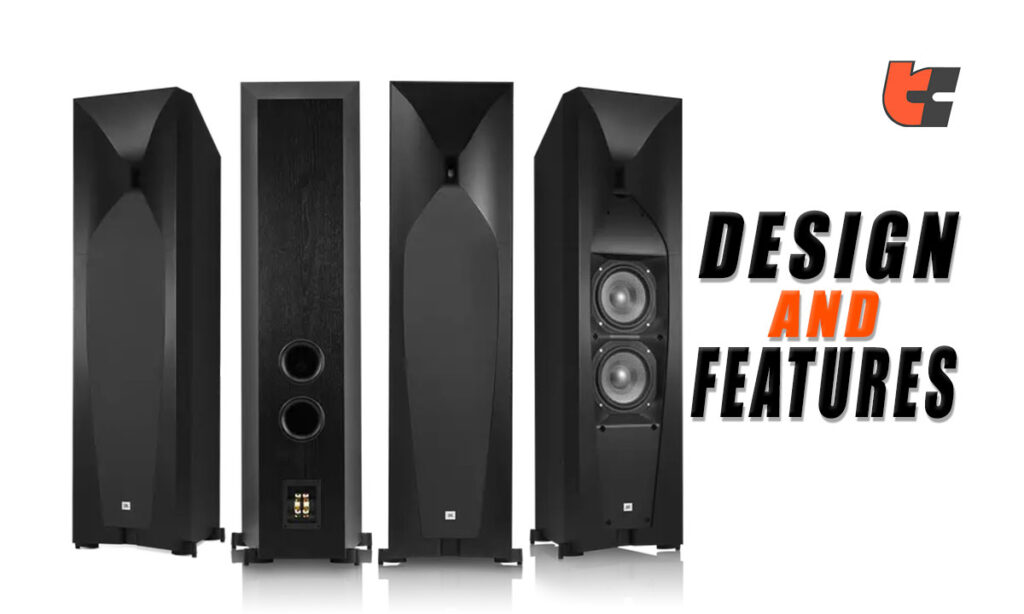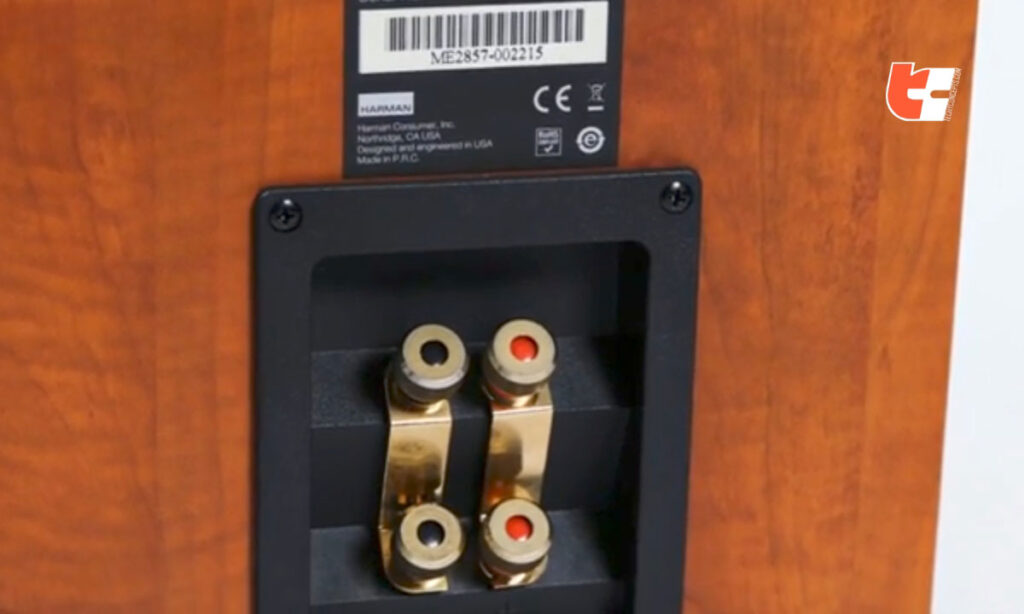In a market saturated with loudspeakers of different brands and varieties, the JBL Studio 590 stands tall in the crowd, promising its users an immersive sound experience.
But, as you think about investing your hard-earned money into this speaker, you might wonder – does it really live up to the hype? Is it truly worth the big investment?
This in-depth review is here to break down the details of this flagship speaker so that you can learn of its pros and cons and be able to figure out yourself whether the JBL Studio 590 stands as a worthy investment for audiophiles like you seeking unparalleled audio quality.
But hold on, before we can take you to the actual review, let us give you a quick overview of its specifications and things you should expect to see in your package.

What’s Included in The Box
- Floor-standing JBL Studio 590 Loudspeaker
- Removable cloth grilles
- Horn cover
- 2 Port tube inserts
- 4 Spiked feet
- User Manual Booklet
- Warranty Card
Specifications in a Glance
- Product Dimensions: 16.5 x 12.8 x 49 inches
- Item Weight: 31.5kg
- Speaker Type: Tower
- Mounting Type: Floor Standing
- Audio Output Mode: Surround
Our Review of the JBL Studio 590 Speaker
We have split our review into five different sub-categories to help you decide your priorities. In this section of this article, we are going to highlight the speaker’s design, sound quality, bass performance and tech features including its drawbacks.
So, without further ado, let’s begin!
Sound Quality and Performance

With a power handling capability of up to 250 watts RMS (1000 watts peak), this speaker can fill even large rooms with robust sound without distortion.
The JBL Studio 590 Speaker is also equipped with dual front-firing bass ports for enhanced low-frequency response, ensuring that every note is reproduced faithfully.
Featuring dual 8-inch PolyPlas drivers and a high-frequency compression driver mounted on a glass-filled Bi-Radial horn, the JBL Studio 590 Speaker produces clear and accurate sound across the entire frequency spectrum, ensuring clarity and precision in both low and high frequencies.
One of the standout features of the JBL Studio 590 Speaker is its dynamic range and ability to reproduce music with accuracy and depth. Whether you’re listening to classical music or watching an action-packed movie, this speaker delivers a truly cinematic experience.
The studio-grade construction of the JBL 590 also contributes to its exceptional sound quality. The rigid MDF enclosure minimizes distortion and resonance, allowing the drivers to operate at their full potential.
Overall, the sound quality and performance of the JBL 590 Speaker make it a top choice for music lovers looking for a premium listening experience.
Design and Features

The JBL Studio 590 Speaker boasts a sleek and modern design that will complement any home entertainment setup. The speaker is tall and slim, making it easy to fit into any room without taking up too much space.
Although there are no magnetic grilles, everything else feels very premium, especially due to its heavy-duty rubber build material.
Its black wood finish and stylish grille give it a sophisticated look, while the iconic JBL logo adds a touch of elegance. The overall build quality is solid and durable, ensuring that the speaker will last for years to come.
One of the standout features of the JBL Studio 590 Speaker is its dual 8-inch PolyPlas woofers, which deliver deep and powerful bass that will fill any room with rich, immersive sound.
The high-frequency transducer features a 1-inch compression driver with a horn to provide clear and detailed treble frequencies. With a frequency response range of 35Hz – 40kHz, this speaker is capable of reproducing a wide range of audio frequencies with accuracy.
Ports and Inputs
In terms of connectivity options, this speaker offers bi-wire capability for enhanced audio performance and flexibility in setup.
To be more explicit, the JBL Studio 590 only features RCA and XLR inputs,

which should be good enough for average home theater systems. However, to be honest, we do wish that the speaker supported Bluetooth, had an HDMI port or USB connectivity to facilitate quick pairings with multiple external devices.
It also features a switch with which you can alter the high-frequency output of the listening environment by turning on either mono or stereo mode.
Few Limitations of the JBL Studio 590 Speaker
And just like our lives, this JBL 590 speaker is not perfect either.
Apart from its lack of wireless connectivity options, another limitation of the JBL Studio 590 loudspeaker is its limited frequency response compared to other high-end speakers in its class.
While the Studio 590 offers a respectable frequency range of 35Hz to 40kHz, some competitors in a similar price range may offer a wider frequency response, allowing for more detailed and accurate sound reproduction across the entire audio spectrum.
This limitation can be particularly noticeable when listening to music with deep bass or intricate high-frequency details. All in all, the restricted frequency response of the Studio 590 may result in less clarity and definition in these areas, potentially impacting the overall listening experience for audiophiles seeking a more immersive and dynamic sound.
Secondly, the JBL 590 speaker’s large size and weight may also pose problems for some users. Measuring over 4 feet tall and weighing around 70 pounds, this loudspeaker takes up a significant amount of space and can be difficult to move around.
This may not be ideal for users with limited living space or those who frequently rearrange their furniture, additionally making it challenging to integrate the speaker into smaller rooms or home theater setups.
Furthermore, the bulky design of the loudspeaker may not appeal to everyone aesthetically, as it can dominate a room’s decor.
Moving on, another crucial drawback of the JBL Studio 590 loudspeaker has to be its high price point. With a premium price tag, this speaker may not be accessible to budget-conscious individuals or those looking for a more affordable option.
Additionally, the high price point may also make it difficult for consumers to justify purchasing multiple units of the JBL Studio 590 for a complete home theater system or multi-room setup. This can further restrict its appeal and usability for those looking to create an immersive audio experience throughout their living space.
Overall, while the JBL Studio 590 offers impressive sound quality and performance, some potential buyers may still not find this loudspeaker up to their expectations and worth investing over due to its steep price tag, large size and weight, and average frequency range.
Our Final Verdict
In conclusion, there’s no shadow of a doubt that the JBL Studio 590 Speaker is worth investing in as it does offer top-notch sound quality with its large high-frequency compression drivers. Its bass response is powerful and well-defined, making it suitable for music enthusiasts and home theater setups alike.
Well, although the price point may seem unreasonable and its large size can be cumbersome for some, we would still recommend the JBL Studio 590 speaker to anyone who’s looking for a high-quality speaker with exceptional sound performance and don’t mind investing in a premium product.
Frequently Asked Questions
Q.1: Can You Connect JBL Studio 590 Speaker With TV?
Answer: Yes, you can connect JBL Studio 590 speakers to a TV. Use an audio cable, typically a 3.5mm stereo cable or RCA cables, depending on the available ports on both the speakers and the TV. Connect one end of the cable to the audio output on your TV and the other end to the input on the JBL Studio 590 speakers. Make sure to select the correct input source on the speakers. If your TV supports Bluetooth but your JBL Studio 590 speakers do not, you might need a Bluetooth transmitter for wireless connectivity. Lastly, adjust your TV’s audio settings and everything should be set now.
Q.2: How to Pair Laptop With JBL 590 Speaker?
Answer: Because the JBL Studio 590 speakers do not have Bluetooth capability, you have to connect them to your laptop using an audio cable such as RCA. Connect one end of the cable to the audio output on your laptop and the other end to the input on the JBL Studio 590 speakers. Adjust your laptop’s audio and volume settings to ensure the sound gets routed to the connected speakers.
Q.3: What is The Wattage of Each JBL Studio 590 Speaker?
Answer: Each JBL Studio 590 speaker has a power handling capacity of up to 250 watts RMS (Root Mean Square) and a peak power handling of 500 watts.
Q.4: Can You Adjust The Treble or The Bass Separately on JBL Studio 590?
Answer: Unfortunately no, there’s no option to adjust the bass and treble settings separately.

